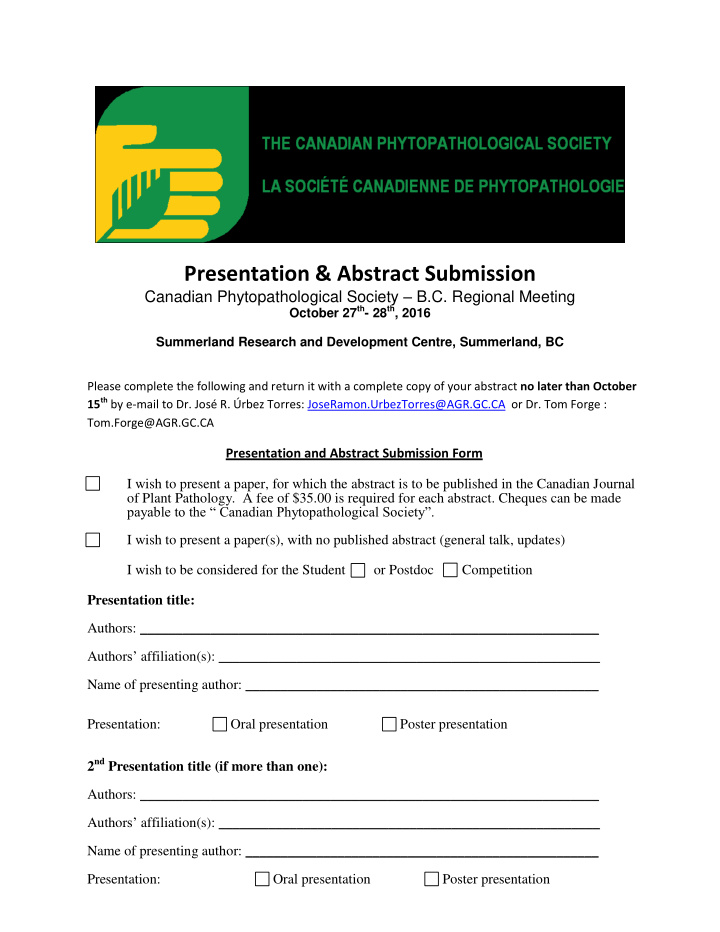



Presentation & Abstract Submission Canadian Phytopathological Society – B.C. Regional Meeting October 27 th - 28 th , 2016 Summerland Research and Development Centre, Summerland, BC Please complete the following and return it with a complete copy of your abstract no later than October 15 th by e-mail to Dr. José R. Úrbez Torres: JoseRamon.UrbezTorres@AGR.GC.CA or Dr. Tom Forge : Tom.Forge@AGR.GC.CA Presentation and Abstract Submission Form I wish to present a paper, for which the abstract is to be published in the Canadian Journal of Plant Pathology. A fee of $35.00 is required for each abstract. Cheques can be made payable to the “ Canadian Phytopathological Society”. I wish to present a paper(s), with no published abstract (general talk, updates) I wish to be considered for the Student or Postdoc Competition Presentation title: Authors: _________________________________________________________________ Author s’ affiliation(s): ______________________________________________________ Name of presenting author: __________________________________________________ Presentation: Oral presentation Poster presentation 2 nd Presentation title (if more than one): Authors: _________________________________________________________________ Author s’ affiliation(s): ______________________________________________________ Name of presenting author: __________________________________________________ Presentation: Oral presentation Poster presentation
Canadian Journal of Plant Pathology Abstract Submission Requirements Deadline October 15 th /2016 To ensure that the abstracts have a uniform format for rapid publication, please adhere to the following guidelines for submitting abstracts. Software: Please prepare abstracts using Microsoft Word. Abstract font ● Times New Roman font and 12 point preferred Abstract title ● in bold, scientific names italicised ● only the first word of the title, proper names, and scientific names have the first letter capitalized Author names ● in normal font, initial(s) first, followed by last name, letters capitalized (e.g. A.B. SMITH) Affiliations ● in italics and need to include postal address and postal code (no abbreviations except for province or state names) ● first affiliation shoul d be that of the first author. If other authors have different affiliations, those affiliations should start with the authors initials, e.g. (C.B.J.) Abstract body ● in normal font with scientific names italicised ● should be no more than 250 words ● sc ientific authorities are to be given for all Latin names the first time they are mentioned in the body of the abstract ● abbreviations, nomenclature, symbols for units of measurements, etc. are to conform to the requirements for manuscripts submitted to CJPP (see CJPP instructions to authors) Below the abstract, clearly indicate the following: - Name of the person presenting the paper along with a telephone number and/or email address - Names of two people (other than the authors) who have critically read the abstract. The following is an example of a recently published abstract. Other examples of abstracts published in CJPP can be found in volume 38(1):134-137(2016). Complete addresses should be given in the format shown below.
Sample Abstract: Impacts of ring nematodes (Mesocriconema xenoplax) on self-rooted Merlot and selected rootstocks under Okanagan Valley growing conditions. R. SMIT, T. A. FORGE, C. KOCH, G. H. NEILSEN AND D. NEILSEN. Pacific Agri-Food Research Centre ( PAFRC ) , Agriculture and Agri-Food Canada ( AAFC ) , 6947 Highway 7, Agassiz, BC V0M 1AO, Canada; and ( G.N., D.N. ) PAFRC, AAFC, P.O. Box 5000, 4200 Highway 97, Summerland, BC VOH IZO, Canada Several species of plant parasitic nematodes, including Mesocriconema xenoplax (Raski) Loof & De Grisse have been found in Okanagan Valley vineyards that appear to be declining in productivity and have sparse, often necrotic root systems. Research conducted on relatively fine-textured soils in coastal Oregon and California indicated that M. xenoplax can cause significant reductions in grapevine root growth and vigour, but the impact of M. xenoplax on grapevines under Okanagan Valley growing conditions is unknown. Our research objectives were to: (1) determine if M. xenoplax has detrimental effects on growth of self-rooted vines and three rootstocks growing in a sandy soil typical of many Okanagan Valley vineyards, and (2) determine if application of compost to the root zone of grape affects M. xenoplax population densities. In spring 2007, field microplots were fumigated, inoculated with the nematode (control microplots were not inoculated), and planted with self-rooted Merlot or plants of Merlot grafted onto rootstocks of Riparia Gloire, 44-53M or 3309C. In spring 2009, M. xenoplax trunk diameters and pruning weights of self-rooted vines were lower in M. xenoplax -inoculated microplots than in non-inoculated microplots. In contrast, rootstocks were not affected by the nematode. Composted poultry manure was applied as the primary source of nitrogen to experimental plots in two different mature vineyards; the application rate was intended to result in similar available N as fertilizer-treated control plots. The compost was applied for three years and then nematode populations were assessed at the end of the third year and at three dates in the fourth year. Population densities of M. xenoplax were greater in compost-amended plots than in fertilizer-treated plots. Abstract Reviewed by : I.M. Fast I.M. Right
Recommend
More recommend